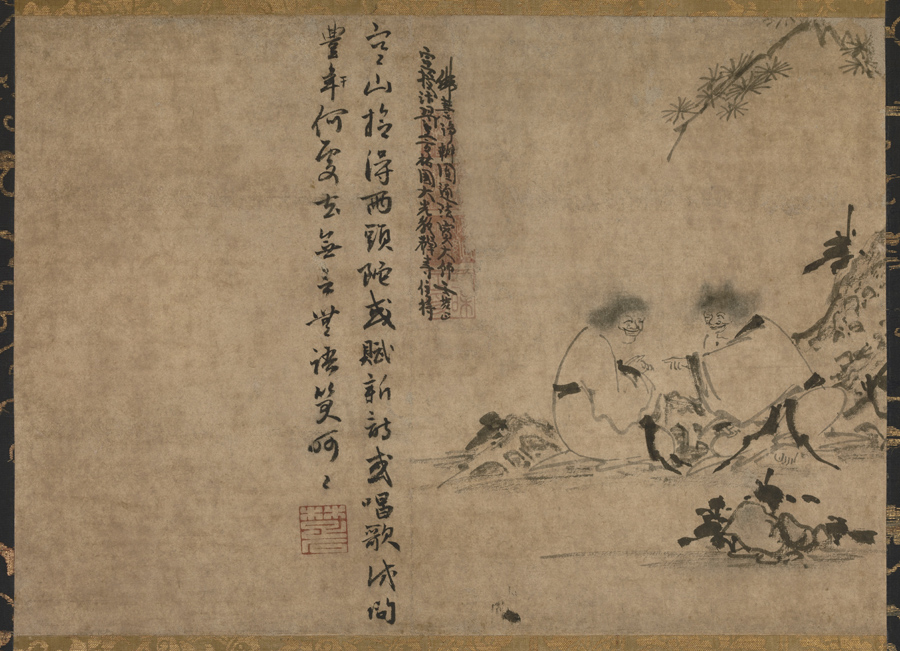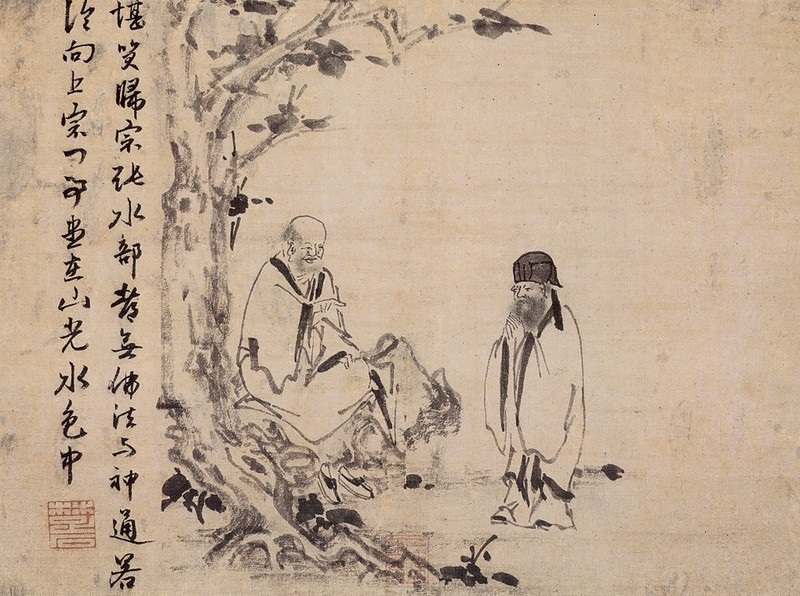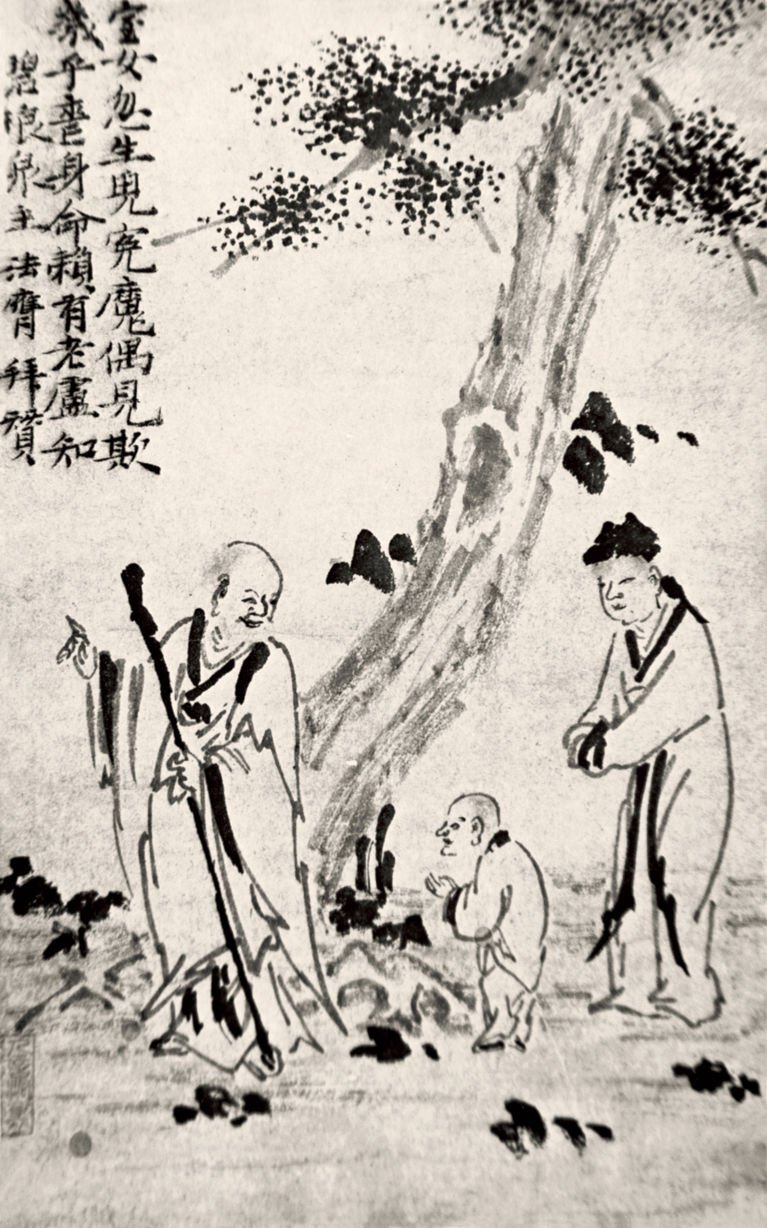ZEN MESTEREK ZEN MASTERS
« Zen főoldal
« vissza a Terebess Online nyitólapjára
梵因陀羅
Fanyin Tuoluo, a.k.a. 因陀羅 Yintuoluo
(active 14th century)
(Rōmaji:) Indara
Yintuoluo was a Chan monk from India who lived in China during the Yuan dynasty (1271-1368), and served as the abbot of a temple in Kaifeng. He is known for his paintings, in particular one of Hanshan and Shide, a National Treasure today held at the Tokyo National Museum.
The name Yintuoluo, or Indara in Japanese, also refers to the Hindu goddess Indra.

寒山拾得図(禅機図断簡のうち)
Hanshan and Shide
Album leaf, ink on paper, 35 x 49.5 cm, Tokyo National Museum
Hanshan and Shide are two legendary figures of the Tang dynasty (618-907), who are said to have lived in Guoqing Temple (國清寺) on Mt. Tiantai (天臺山, in today's Zhejiang province) where they trained with the Chan (Zen) master Fenggan (豐幹). Following the Song period (960-1279), paintings of Hanshan and Shide were favored by Chan monks. Scenes of Zen Enlightenment took as its subject anecdotes related to Chan Buddhism. Hanshan and Shide are depicted roaring with laughter without answering any of the questions put to them by Fenggan. While the method of delicately rendering the faces and of executing the robes with a coarse brush follows the traditional depiction of figures in ink painting, this work also bears the mark of Yintuoluo's abbreviated style.
Paintings by Yintuoluo were highly prized in Japan. The box that accompanies this work carries an inscription by the well known tea master and governor of Matsue, Matsudaira Fumai (1751-1818), and from it we know that this famous work was formerly in the possession of the Asano family.

Hanshan, Shide, Fenggan and tiger
Attributed to Yintuoluo
Kyoto National Museum


寒山拾得図
Hanshan and Shide
75.8 × 31.5 cm, Tokyo National Museum

Detached segment of the Deeds of the Zen Masters 紙本墨画禅機図断簡, shihon bokuga zenkizu dankan):
Priest Zhichang and courtier Libo (智常・李渤図, chijō ribotsuzu)
Yin's painting features an encomium by Chushi Fanqi 楚石梵琦 (1296-1370), which identifies the scene as a meeting between Guizong Zhichang 歸宗智常 (757-821) and Li Bo 李渤 (773-831).
畠山記念館 Hatakeyama Memorial Museum

Detached segment of the Deeds of the Zen Masters (紙本墨画禅機図断簡, shihon bokuga zenkizu dankan):
Priest Zhichang (智常禅師図, chijō zenjizu).
Handscroll, 35.3 cm x 48.3 cm. Ink on paper.
Located at the Seikado Bunko Art Museum, Tokyo.
The scroll has been designated as National Treasure of Japan in the category paintings.

Detached segment of the Deeds of the Zen Masters (紙本墨画禅機図断簡, shihon bokuga zenkizu dankan):
Tanka [Danxia Tianran] burning Buddhist statues (丹霞焼仏図, tanka shōbutsuzu).
Handscroll, 35.0 x 36.8 cm. Ink on paper.
Located at the Ishibashi Museum of Art, Kurume, Fukuoka.
Encomium by Chushi Fanqi 楚石梵琦 (1296-1370):
In an ancient temple under frozen skies he passed a night,
Unremitting wind and drift upon drift of snow,
If indeed there are no relics, what makes it so special?
So he took the wooden Buddha from the hall and burnt it.
古寺天寒度一宵,不禁風冷雪飄飄 , 既無舍利何奇特 ? 且取堂中木佛燒。
![[Emléktáskák és szerzetesek napjai] Japán Yuan-dinasztia Zen festményeinek elvesztése <wbr> Indra festmények <wbr> Chu Shi Fanqizan <wbr> Zsákok Jiang Mo Q & A diagram <wbr> Ãrtékelés](Indara_Hotei1.jpg)
![[Emléktáskák és szerzetesek napjai] Japán Yuan-dinasztia Zen festményeinek elvesztése <wbr> Indra festmények <wbr> Chu Shi Fanqizan <wbr> Zsákok Jiang Mo Q & A diagram <wbr> Ãrtékelés](Indara_Hotei2.jpg)
Detached segment of the Deeds of the Zen Masters (紙本墨画禅機図断簡, shihon bokuga zenkizu dankan):
Budai (Hotei) (布袋図, hoteizu).
Handscroll, 35.6 cm x 48.5 cm. Ink on paper. Located at Nezu Art Museum, Tokyo.
The scroll has been designated as National Treasure of Japan in the category paintings.
This work depicts the scene of a discussion in which Jiang Mohe became certain one day that the monk Budai was an incarnation of Maitreya, the future Buddha. This painting, with its distinctive style, making effective use of dark and light shades of sumi ink, is by Yintuoluo, who was also a Zen monk in China. Chushi Fanqi, who contributed the poetic inscription, was also a Chinese Zen monk , one who became highly influential in China and in other countries.


五祖再來圖 The Second Coming of the Fifth Patriarch
245 x 62 cm
Cleveland Museum of Art

因陀羅 《弘忍再來圖》
大滿弘忍 Daman Hongren (601-674)

Bodhidharma Crossing the Yangzi on a Reed 蘆葉達摩圖
Attributed to Yintuoluo 因陀羅 (14th century) Yuan (1271-1368)
Hanging scroll, ink on paper, 79.4 x 31.1 cm
Fukuoka City Art Museum

Bodhidharma Crossing the Yangzi on a Reed 蘆葉達摩圖
Attributed to Yintuoluo 因陀羅 (14th century)
Before 1325, Yuan (1271-1368)
Encomium by Yunwai Yunxiu 雲外雲岫 (d. 1325 )
Hanging scroll, ink on paper, 66.6 x 30 cm
Encomium:
Stepping on a reed and crossing the river
Eyes filled with mist and spray,
Nine years facing a wall,
Measured calculations are like the counting of five petals,
[Which in] the chaos of spring open from a single flower.
Eulogised by Yunwai of Tiantong [Monastery]
踏蘆渡江, 滿目煙波, 九年面壁,計較猶多五葉, 春亂開一花。 天童 雲岫贊 。


“Chuanzi and Jiashan”
by 梵因陀羅 Fanyin Tuoluo, a.k.a. Yintuoluo (14th century)
Hanging scroll, ink on paper, 57.4 x 29.1 cm.
Artist's seals:
Shamen Fanyin (“The Buddhist Monk Fanyin”);
Renyan tungli taohuaruan, weibi renjian yu cizhi (“People say in the Immortal's grottos peach blossoms bloom in warm spring; it is not likely that such branches exist in our world too”)